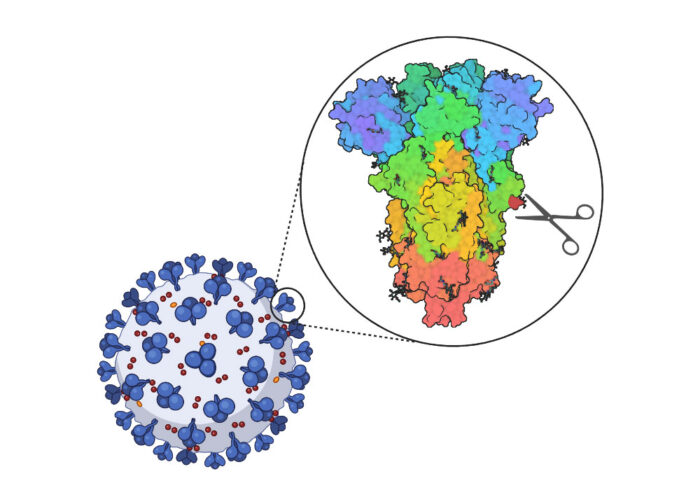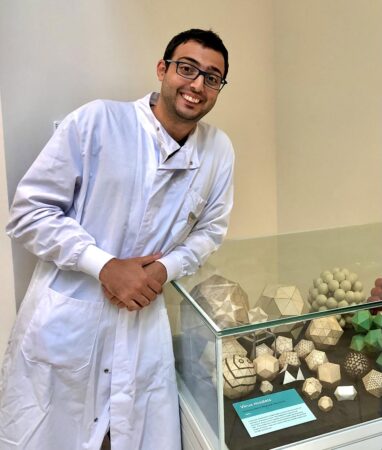The human protease furin is not required for processing of the SARS-CoV-2 Spike protein to enable virus-cell membrane fusion and infection

A primary focus of research into COVID-19 over the last year has been the SARS-CoV-2 Spike protein that allows viral entry into our cells, initiating infection. Before infection is triggered, Spike must be cleaved to reveal the peptide that drives virus-cell membrane fusion. Scientists had thought that the protease furin was responsible for this cleavage, but new work from Leo James’ group, in the LMB’s PNAC Division, shows that furin is not essential for SARS-CoV-2 infection, suggesting that antiviral treatments based exclusively on furin inhibitors may be less effective than expected.
One of the peculiarities of SARS-CoV-2 is that Spike is also expressed on the surface of infected cells and, just as it drives virus-cell membrane fusion from the virus surface, it can trigger fusion between neighbouring cells, leading to the formation of enlarged cells containing multiple nuclei. This process might play a role in virus spread between cells even in the absence of production of new virus particles. As Spike is performing a similar role in cell-cell fusion as in mediating virus entry, the same cleavage process is required to reveal the fusion machinery.
Using this cell-cell fusion capacity, Guido Papa, a postdoc in Leo’s group, developed an assay that allowed the team to measure the rate at which fusion occurs in different conditions. Using this assay and other data from experiments done by Donna Mallery and Anna Albecka, the team were able to determine that furin is not essential for Spike cleavage and is not essential for viral replication, although it strongly promotes it, but that cleavage is essential for cell-cell fusion, suggesting that other proteases process Spike in the absence of furin and that inhibiting furin won’t completely block viral entry, replication or cell-cell fusion.
Despite the rapid development and deployment of vaccines against COVID-19, antiviral drugs are also urgently needed to help treat the disease. These findings demonstrate that antiviral treatments based on furin inhibition will not completely prevent viral infection and that a cocktail of protease inhibitors might instead be required. This work also highlights that blocking Spike cleavage could also be beneficial in reducing viral spread through cell-cell fusion. Lastly, the tools and assays developed in this work could be of great benefit for the future assessment of new variants of SARS-CoV-2 that have mutations around the Spike cleavage site, as the new UK B.1.1.7 strain does.
The work was funded by UKRI MRC.

Personal perspectives of COVID-19 research
We are accompanying Insights on Research that cover COVID-19 research with interviews with the scientists who carried out the work, to give some perspective of the experiences of transitioning to COVID-19 research and working at the LMB during the height of the ongoing pandemic. One member of Leo’s group who led this research on the role of furin in virus-cell and cell-cell membrane fusion, Guido Papa, describes why he ended up doing this work and what it was like working on this project.
What is your normal research focus?
My research is mainly focused on the Human Immunodeficiency Virus (HIV) and the mechanisms by which HIV is able to exploit some cellular cofactors to promote infection, ensuring capsid integrity and protecting its genome from intracellular immunity.
Why did you change focus to work on COVID-linked research?
I started my postdoc at the LMB in January 2020, just before the beginning of the COVID-19 pandemic. I have been studying viruses since my undergraduate degree and, as a virologist, I felt I had to give my contribution to COVID research and join the global fight against the pandemic by putting in place my expertise and knowledge in virology. With the support of my supervisor, Leo, and the group, we developed some assays to investigate the role of Spike, one of the most important SARS-CoV-2 viral proteins.
How might this research make a difference to the pandemic outcome?
We decided to focus our research on the Spike protein, which is one of the main SARS-CoV-2 surface proteins and also the main target for SARS-CoV-2 vaccines. We believe that an extensive knowledge of the biological processes in which this protein is involved could help improve current strategies to treat COVID-19 infections. Lately, several SARS-CoV-2 variant strains have arisen around the world and most of them contain mutations in the Spike protein, so having assays and tools to investigate how these mutations impact different steps of viral replication will be crucial to fight this pandemic.
What has been different in the lab during the pandemic?
Everything changed suddenly for me. When I first joined Leo’s group I liked the dynamism of the LMB environment, the social interactions with my colleagues, and also the teatime at 5 pm where we used to discuss various topics including scientific problems. During the lockdown, the institute changed completely. It was quiet, there were very few people working in the lab and I started missing all those things (…and especially the teatime discussions at 5pm!).
Was collaboration important?
Yes, absolutely! The whole project wouldn’t have been possible without the help of all the people involved in this research. In particular, Donna Mallery established some of the SARS-CoV-2 assays and collected pseudovirus infection data while Anna Albecka, together with Jillian Deans and Chris Tate established a working Containment Level 3 laboratory at the LMB. This was a game-changer in our SARS-CoV-2 research as it allowed us to perform experiments with the SARS-CoV-2 live virus.
We also collaborated with several groups at the LMB (Sean Munro’s group, Harvey McMahon’s group) and at Addenbrookes hospital (Ian Goodfellow’s group), who all contributed with their expertise.
What next? Will your involvement in COVID research continue or are you returning to your normal research focus?
The emergence of new SARS-CoV-2 variants is a real concern as they can threaten the effectiveness of the approved SARS-CoV-2 vaccines. I will definitely carry on with this basic science investigating the biology of this interesting virus in more detail, not only focusing on Spike protein but also trying to find new target antigens for more effective vaccines and treatments.
Further references
Furin cleavage of SARS-CoV-2 Spike promotes but is not essential for infection and cell-cell fusion. Papa, G., Mallery, DL., Albecka, A., Welch, LG, Cattin-Ortolá, J., Luptak, J., Paul, D. McMahon, HT., Goodfellow, IG., Carter, A., Munro, S., James, LC. PLOS Pathogens https://doi.org/10.1371/journal.ppat.1009246
Leo’s group page
Sean’s group page
Harvey’s group page
Ian Goodfellow’s page
LMB joins the fight against COVID-19